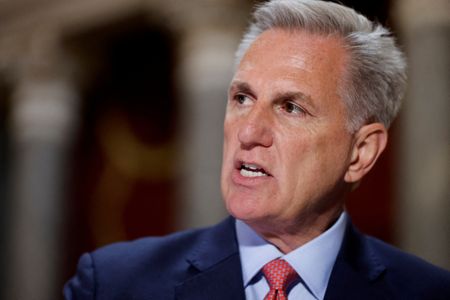
By Kanishka Singh and Andy Sullivan
WASHINGTON (Reuters) – Republicans in the House of Representatives on Monday laid plans to advance a debt-ceiling deal with Democratic President Joe Biden starting Tuesday, with the aim of passing it through Congress before the U.S. government runs out of money early next week.
The House Rules Committee said it would take up the agreement on Tuesday afternoon, which could clear the way for a vote by the Republican-controlled chamber.
The package also must pass the Democratic-controlled Senate before Biden can sign it into law.
The U.S. Treasury Department says the United States could default on its obligations as soon as June 5 if Congress does not act.
Prospects are uncertain, as lawmakers on the left and the right have objected to the deal. Representative Raul Grijalva, a progressive Democrat, wrote on Twitter that its changes to environmental rules were “disturbing and profoundly disappointing.”
The newsletter Punchbowl, citing Republican sources, said a preliminary estimate from the nonpartisan Congressional Budget Office showed the deal could save up to $2 trillion if its spending caps were left in place for six years, though much of that depends on which party controls Congress over that time. It was not clear when CBO would release its official estimate.
The 99-page bill would suspend the debt limit through Jan. 1, 2025, allowing lawmakers to set aside the politically risky issue until after the November 2024 presidential election.
It would cap discretionary spending in the next two fiscal years, claw back unused COVID-19 funds, speed up the permitting process for some energy projects and stiffen work requirements for food aid programs for poor Americans.
It would also shift some funding away from the tax-collecting Internal Revenue Service, though White House officials say that should not undercut enforcement in the near term.
House Speaker Kevin McCarthy, who negotiated the deal with Biden, has predicted it will draw the support of most of his fellow Republicans. House Democratic Leader Hakeem Jeffries said he expects support from his side of the aisle.
It could face a rocky reception in the Rules Committee, normally closely aligned with House leadership. McCarthy was forced to put some skeptical conservatives on the panel as a price for winning the speaker’s gavel.
McCarthy told reporters on Monday he was not worried about the package’s prospects in the committee.
Initial reaction has been positive from financial markets, which would be thrown into chaos if the United States was unable to make payments on its securities, which form the bedrock of the global financial system.
But some investors are wary that the spending cuts secured by McCarthy could weigh on U.S. growth. Investors are also bracing for potential volatility in the U.S. bond market.
Republicans have argued that steep spending cuts are necessary to curb the growth of the national debt, which at $31.4 trillion is roughly equal to the annual output of the economy.
Interest payments on that debt are projected to eat up a growing share of the budget in the decades to come as an aging population pushes up health and retirement costs, according to government forecasts.
The deal would not do anything to rein in those fast-growing programs. Most of its savings would come by capping spending on domestic programs like housing, border control, scientific research and other forms of “discretionary” spending. Military spending would be allowed to increase over the next two years.
(Reporting by Andy Sullivan; Additional reporting by Gram Slattery; Editing by Andrea Ricci)
